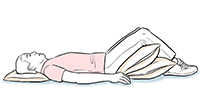Postural Drainage
Postural drainage is a way to change your body position to help your lungs drain. You lie with your chest lower than your belly (abdomen). This can help loosen and drain extra mucus from your lungs. It's helpful if you have a long-term (chronic) lung problem that causes a lot of mucus. It's also helpful if you have a lot of mucus from an infection. The guidelines below will help you know what to do.
General guidelines
Check with your doctor before trying this therapy.
Find positions that are comfortable for you. You can lie on a bed or on the floor, using pillows. Try some of the positions that are described below.
Stay in each position for at least 5 minutes.
When you feel the urge to cough, sit up and do controlled coughing. An example is huff coughing. You cough with just enough force to loosen mucus and carry it through your airways without causing them to narrow and collapse.
Make sure to do postural drainage before meals or at least 90 minutes after eating. This helps prevent vomiting.
If your doctor prescribed medicines, such as a bronchodilator or inhaler, ask how long to wait to do postural drainage after using the medicine.
Postural drainage may be used with other therapies. Examples are chest percussion, vibration, or use of a flutter valve. Talk with your doctor first. Don't use these treatments at the same time unless your doctor says it's okay.
When not to do postural drainage
Always talk with your doctor before starting postural drainage. Don't try this therapy if you:
Have mild pain when you are in certain physical positions.
Are coughing up blood.
Have rib fractures.
Are using blood-thinning medicines.
Have vertebral fractures or osteoporosis.
Have orthostatic hypotension or postural hypotension. These conditions can cause a sudden drop in blood pressure when you stand up from a sitting or lying position.
On your back
Try this position to drain the front of your lungs.
Lie on a slanted surface with your chest lower than your hips.
Place a small pillow under your head. Put 2 pillows under your bent knees.
Rest your arms at your sides and breathe in through your nose and out through your mouth. Remember: Always breathe out for longer than you breathe in. This allows your lungs to empty as much as possible.
On each side
Try this position to drain the sides of your lungs.
Place a small pillow under your head and 2 or 3 pillows under your hips.
Lie on one side with your chest lower than your hips.
Breathe in through your nose. Breathe out through your mouth.
After 5 to 10 minutes, switch to the other side.
On your stomach
Try this position to drain the back of your lungs.
Put 2 or 3 pillows under your stomach.
Drape your body over the pillows so that your chest is lower than your hips.
Rest your arms by your head.
Breathe in through your nose. Breathe out through your mouth.
Follow-up care
Make a follow-up appointment as directed.
When to contact your doctor
Contact your doctor right away if you have:
Wheezing or constant coughing.
Symptoms that get worse, or you have new symptoms.
Increased mucus.
Yellow, green, brown, bloody, or smelly mucus.
Fever of 100.4°F (38°C) or higher, or as directed by your doctor.
Fast or irregular heartbeat.
Swollen ankles.
Pain.
Call 911
Call
Trouble breathing.
Confusion or trouble staying awake.
Loss of consciousness or fainting.
Chest pain or tightness.
Skin that is a blue color.
Coughing up blood.
Severe pain.


